“Come inside!” A little old man invited me in a leprosy hospital in Malaysia.
“Do you think that one-to-one discipleship is too slow?” a church elder asked Pastor Tim and me in South Korea.
“Do you like the food?”—a common question we encountered in both countries!
These few words and pictures failed to adequately describe all that we saw and experienced during our whirlwind trip in Oct 2013 to the two Asian countries. Unlike Pastor Tim, this was my first time to Kuala Lumpur, Malaysia and Seoul, South Korea. My first impression of Malaysia was “many languages, many cultures.” Our typical conversations would involve using two or three languages at once! I exhausted much of my Mandarin, some of my English, and virtually all of my Cantonese vocabulary! Everywhere we went, there were people of all different ethnicities and cultures-Malay, Indonesian, Chinese, Indian, etc. Another strong impression of Malaysia was the conspicuous Islamic influence. Many women wore hijabs and other Islamic clothing. About half the population is were Muslim. The rest follow Buddhism, Hinduism, Christianity, Daoism, etc.
While in Malaysia, Pastor Tim taught a 3 ½-day seminary class organized by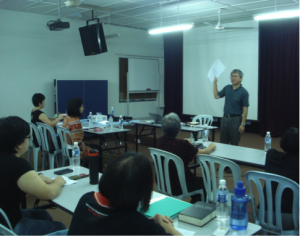 Malaysian Baptist Theological Seminary and the Baptist Convention of Malaysia. Many pastors and lay leaders from various churches attended the seminars on 1, 2, and 3 John. He shared some of his pastoral experiences with them as well. In between classes, Pastor Tim also preached for an evening revival meeting and Sunday services.. His voice was quite hoarse when he was all done! Meanwhile, I did music recording for four Mandarin worship songs with my music producer at his recording studio. I hope to produce a new Chinese worship CD sometime next year. I also had a chance to witness to a Pakistani custodian working in the
Malaysian Baptist Theological Seminary and the Baptist Convention of Malaysia. Many pastors and lay leaders from various churches attended the seminars on 1, 2, and 3 John. He shared some of his pastoral experiences with them as well. In between classes, Pastor Tim also preached for an evening revival meeting and Sunday services.. His voice was quite hoarse when he was all done! Meanwhile, I did music recording for four Mandarin worship songs with my music producer at his recording studio. I hope to produce a new Chinese worship CD sometime next year. I also had a chance to witness to a Pakistani custodian working in the  church where the seminary classes were held. I also shared the gospel with two Chinese taxi drivers while traveling to and from the recording studio. Earlier that day, God moved me to bring a copy of my previous Chinese CD before heading to the studio. Consequently, I ended up giving the CD to one of the taxi drivers so he can listen to more gospel messages and songs.
church where the seminary classes were held. I also shared the gospel with two Chinese taxi drivers while traveling to and from the recording studio. Earlier that day, God moved me to bring a copy of my previous Chinese CD before heading to the studio. Consequently, I ended up giving the CD to one of the taxi drivers so he can listen to more gospel messages and songs.
One of my most memorable experiences in Malaysia was visiting a leprosy hospital which was housed in old World War II army barracks. Pastor Tim and the female evangelist who hosted us walked into the male patient ward without hesitation. They ended up leading a male leper to the Lord! I was pretty reluctant to go inside, so God moved a little old man to wheel himself up to me and invited me in! He told me that he had leprosy for 3 years and felt very lonely. Even though he didn’t believe in the Bible, the Lord moved me to encourage him to seek God when he’s lonely. I told him that even when all his friends, family, relatives had deserted him, God will never forsake him. Another male leper was well known among church members who regularly visited him. His wife had abandoned him when his leprosy flared up again. The church members prayed that his wife will contact him again after many years of silence. Recently, he reported to the evangelist that his wife had visited him 3 weeks ago. This was an answer to their prayers! He also promised the evangelist that he’ll start attending church services.
We toured several different churches in Malaysia. At 120 years old, Gereja Gospel Hall is the oldest Chinese church in Chinatown. Today, it still has a vibrant youth ministry. Pantai Baptist has an active counseling ministry but is 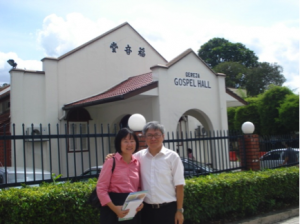 ironically located next to a large ornate Buddhist temple! Dream Centre (a Methodist church) is a huge multiethnic church whose pastor was recently threatened. But because of his deep faith and firm convictions, he courageously continued his ministry. Full Gospel Assembly has three different prayer ministries—a prayer tower, several prayer closets, and 24/7 prayer schedule. They have four prayer meetings at the church on weekdays! We were deeply encouraged by their ministries and ever mindful of the unique spiritual challenges each church faces. The situation reminds me of the seven churches in Revelations 2-3, with different trials that tested their faith. To each of the seven churches, this last verse is given: “He who has an ear, let him hear what the Spirit says to the churches.” (Rev. 2:11)
ironically located next to a large ornate Buddhist temple! Dream Centre (a Methodist church) is a huge multiethnic church whose pastor was recently threatened. But because of his deep faith and firm convictions, he courageously continued his ministry. Full Gospel Assembly has three different prayer ministries—a prayer tower, several prayer closets, and 24/7 prayer schedule. They have four prayer meetings at the church on weekdays! We were deeply encouraged by their ministries and ever mindful of the unique spiritual challenges each church faces. The situation reminds me of the seven churches in Revelations 2-3, with different trials that tested their faith. To each of the seven churches, this last verse is given: “He who has an ear, let him hear what the Spirit says to the churches.” (Rev. 2:11)
In contrast, South Korea is a land of “one language, one culture.” Most of them did not recognize addresses written in English. Almost all menus were in Korean only. We ordered food by pointing to pictures of food and speaking one or two  English words! We were always mistaken for natives until we started speaking! Pastor Tim proved his God-given navigational skills by traversing the Korean subways to various churches and tourist attractions. He drove all over Seoul without a tour guide, and by God’s mercy we didn’t get lost! Whenever we asked for directions, all the Koreans, young and old, in business districts and in residential areas, would stop whatever they were doing to help us. I marveled at the Korean palaces built hundreds of years ago, still bearing Chinese characters across every doorway and entrance! Even the architecture was strikingly similar to the Chinese palaces in Beijing. Fast forward to October 2013- we saw an artist at the Disabled People Culture and Art Festival. He was writing Chinese calligraphy with masterful strokes. I now know that China and Korea had more threaded history than I originally realized!
English words! We were always mistaken for natives until we started speaking! Pastor Tim proved his God-given navigational skills by traversing the Korean subways to various churches and tourist attractions. He drove all over Seoul without a tour guide, and by God’s mercy we didn’t get lost! Whenever we asked for directions, all the Koreans, young and old, in business districts and in residential areas, would stop whatever they were doing to help us. I marveled at the Korean palaces built hundreds of years ago, still bearing Chinese characters across every doorway and entrance! Even the architecture was strikingly similar to the Chinese palaces in Beijing. Fast forward to October 2013- we saw an artist at the Disabled People Culture and Art Festival. He was writing Chinese calligraphy with masterful strokes. I now know that China and Korea had more threaded history than I originally realized!
Do more South Koreans believe in Christianity or Buddhism? About 28% of the people are Christians. Twice we encountered Buddhists and Christians evangelizing on the streets side by side. It seemed to me that the Christians had the upper hand there. Crosses light up at night on the upper floors of office buildings. A regular (not cable) TV channel broadcasts Christian sermons and worship services from well-known Korean mega-churches. The Buddhist broadcasts appear strikingly similar to Christian services. We saw many large well-attended Christian evangelical churches, but no visible Buddhist temple in the areas where we traveled.
We visited five different churches in Seoul and its surrounding areas. Markers Community had a Thursday night young adult worship service. Over 3000 college students and young adults packed the church. The worship service was loud, fun, and Spirit-filled. Some of the songs were translated from familiar English worship songs. At first,, we did not know the directions to the church after the last subway stop. So Pastor Tim asked a young man in a business suit for directions. Out of a hundred-plus people milling around, this young man was waiting for his friends to go to Markers also! Since this was his first time, too, he went inside a 7 Eleven store and found a pair of college-aged sisters to take us to the church. We learned that their father is a pastor and their grandfather was once a missionary to China. The older Sister Seo found out that we can speak Chinese when they saw Pastor Tim reading his Chinese Bible. She had studied Mandarin while living in China for four years. She’s planning to become a missionary herself!
Yonsei Central Baptist Church can seat 20,000 people in its main sanctuary. They also have an impressive 30-plus member youth worship team. We had to take back seats for a Wednesday night service as all the seats in front were occupied! Again the strong presence of the Holy Spirit was evident. What touched me most was the youth worship team. They knelt in front of the cross and prayed for almost an hour before leading the worship!
The “Prayer Mountain” was more like a prayer village! To reach this place took a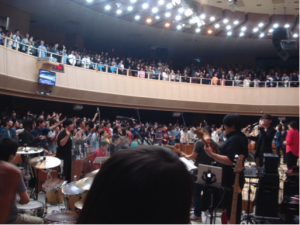 n hour-long bus ride going up. Though it was a Monday morning, the tour bus was full, with the elderly, a few young adults carrying briefcases and some middle-aged riders. The bus goes up and down the mountain several times a day! Even though it was a Monday morning, the huge church sanctuary was far from being empty. People were praying outside on the cemetery ground and in prayer closets. They would come to the prayer mountain, pray for 3-4 hours, and come back down spending almost the entire day! The prayer warriors faithfully set aside the time to pray. Oh, incidentally, they also fasted the whole day! Absolutely no food or restaurant in the prayer mountain!
n hour-long bus ride going up. Though it was a Monday morning, the tour bus was full, with the elderly, a few young adults carrying briefcases and some middle-aged riders. The bus goes up and down the mountain several times a day! Even though it was a Monday morning, the huge church sanctuary was far from being empty. People were praying outside on the cemetery ground and in prayer closets. They would come to the prayer mountain, pray for 3-4 hours, and come back down spending almost the entire day! The prayer warriors faithfully set aside the time to pray. Oh, incidentally, they also fasted the whole day! Absolutely no food or restaurant in the prayer mountain!
On our last day in South Korea, we visited Sa-Rang Community Church, located in the downtown Gangnam business district. Pastor Tim had an in-depth look at this church almost five years ago. The place which first brought first conviction to him on the value of discipleship training. Some of us had visited their sister church, Sa-Rang Community Church in Anaheim, CA for their discipleship training. When we arrived, we witnessed women, mostly young to middle-aged, coming from every direction and flocking to the church in droves. They picked up thick prayer books from the courtyard and went into the sanctuary to pray. We looked at each other and asked, “What’s going on? It’s 10 am on a Tuesday morning!”. Based on my previous experience with Sa-Rang church in California, I assumed this was a women’s discipleship class.
The most in-depth and memorable experience we had was with Onnuri Church, the publisher of our Living Life devotional journals. We spent Saturday morning and all day Sunday worshiping with brothers 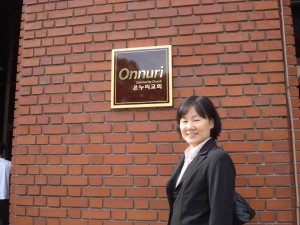 and sisters. The various church leaders answered our questions. We also shared a delicious lunch cooked by their church members. We toured their facilities after lunch. This church has 60,000 members and has another sister church 30-40 min. away with just as many people! There are several Sunday services throughout the day. We began Saturday at the church with an early morning prayer meeting at 5 am (the second meeting starts at 6:30 am!). We noted that everyone had a copy of “Living Life”, even the elderly. We met with church leaders and co-workers after that. Both Deacon An and his wife spoke Mandarin. They hosted us for the entire weekend. He also serves in China where conducts discipleship training for the believers there.
and sisters. The various church leaders answered our questions. We also shared a delicious lunch cooked by their church members. We toured their facilities after lunch. This church has 60,000 members and has another sister church 30-40 min. away with just as many people! There are several Sunday services throughout the day. We began Saturday at the church with an early morning prayer meeting at 5 am (the second meeting starts at 6:30 am!). We noted that everyone had a copy of “Living Life”, even the elderly. We met with church leaders and co-workers after that. Both Deacon An and his wife spoke Mandarin. They hosted us for the entire weekend. He also serves in China where conducts discipleship training for the believers there.
Sister Park welcomed us warmly at Onnuri before the other co-workers arrived. We appreciated her joyful and gracious spirit. Despite our language barrier, we had fun communicating through Google Translate on the iPhone and on papers! Sister Mun spoke to us in Mandarin. She pointed out the importance of one-to-one discipleship as the key to a healthy church. She also shared with us her own quiet time journey as a wife and mother. On impulse, I asked Sister Park and Sister Mun if they had their Living Life journals with them, and both proudly held up their copies. Elder He, who oversees 150 co-workers who in turn conduct one-to-one discipleship, talked to us at length through his interpreter Pastor Lee. He is in charge of missions work to China through the internet. At first, we thought Elder He conducts his disciples training with several people at a time. He told us that he concentrates on one person for 3-4 months – meeting and praying weekly together. Every new believer and regular attendee undergoes 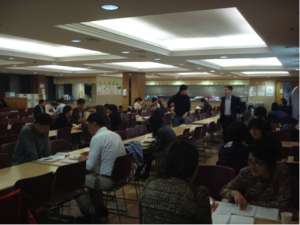 one-to-one discipleship training. Needless to say, we were absolutely flabbergasted. We questioned the efficiency of this process since one can only train 3-4 believers in a year. He looked us right in the eyes and reminded us that discipleship training by multiplication is very efficient. Since 1+1=2, 2+2=4, 4+4=8, 8+8=16, 16+16=32, and so on. This method of discipleship training has grown the Onnuri Church into a spiritually healthy and strong body of Christ made up of tens of thousands of disciples today.
one-to-one discipleship training. Needless to say, we were absolutely flabbergasted. We questioned the efficiency of this process since one can only train 3-4 believers in a year. He looked us right in the eyes and reminded us that discipleship training by multiplication is very efficient. Since 1+1=2, 2+2=4, 4+4=8, 8+8=16, 16+16=32, and so on. This method of discipleship training has grown the Onnuri Church into a spiritually healthy and strong body of Christ made up of tens of thousands of disciples today.
That Sunday morning, we observed many believers engaged in one-to-one discipleship in several rooms. Deacon and Mrs. An brought us to the 11:30 am worship service, which was the third Korean service. Similar to other Korean churches we attended before, the sanctuary was packed. We felt the presence of God so much that many were moved to tears. Both traditional and contemporary worship songs were sung. They had a complete worship band, a string section, and a huge choir! The spiritual rendering of their songs reminded me of the choir at Sa-Rang church in California – very worshipful and majestic. The choir sang worship songs with the band at the beginning of the service. They sang a special anthem in the middle, and sent us off with a final song as the service ended. As a final proof that one-to-one discipleship training really works, Deacon and Mrs. An’s grown children brought us to a nearby park where many young families were picnicking. They introduced us to a couple that they had discipled one-to-one 6 years ago. From the warm fellowship, it was evident that they remained close friends long after the discipleship process was finished. Now this same couple trains other believers. They also served in the Chinese ministry just like their mentors!
Deacon An asked us if we would stay for their Sunday afternoon Chinese worship service in another building. We looked at each other and readily agreed. About 35 years ago, Onnuri began this ministry to reach the Chinese college students living in Korea. The service began with about a hundred young people. Small group discipleship classes were held after the service. As a blessing, no translation was necessary this time! Evangelist Zhou, who preached that afternoon, told us that his family could not afford to put him through seminary. So, Onnuri Church paid for all of his expenses. They trained many young Chinese disciples to become pastors to serve in China. His young family had lived in Korea for several years now, but they plan to return to serve in China.
Two impressions stood out as we conclude our visits to the Korean churches—lots and lots of prayer by many people over many hours, and intentional discipleship training of believers. That was what made these churches such vibrant places of worship – where God’s presence dwells so strongly and people are drawn into fellowship with the Lord and with each other. May our church be so blessed, too!
合二為一:我們的馬來西亞和南韓的短宣之行
作者:(已故)陳胡元玲師母 翻譯:黄耘
編者按: 幾次擱筆,幾次又重新拾起…滿眼是師母的音容笑貌 – 美麗、聰慧、敬虔、篤定…才接到她的文章,尚未完成,她已飄然而去。幾次我重新傾聽聖詩,重新得力,才重新集中精神。斷斷續續,我終於完成了師母文章的翻譯。師母妳未竟的事業我們需要接過來,求主的話語和應許再次使心裡的力量剛強起來,死亡可以暫時隔絕了我們,但主耶稣已經戰勝死亡,天國的盼望也使我們可以跨越死亡。讓我們以此寄思敬爱的師母,也盼望她的遗願 – 門徒培訓可以在我們的教會裡擴展和繼承。
1.馬來西亞之行
「進來吧!」馬來西亞麻瘋病院的一位小老頭邀請我。
「你認為一對一門徒訓練是否進行得太慢了?」南韓的一位教會長老問我和陳牧師。
「你喜歡這些食物嗎?」在這兩個國家都常常被問到的問題!
短短數言和幾幅照片,無法盡情表達我們2013年十月在這兩個亞洲國家旋風般的旅行所經歷的一切。這是我第一次到大馬吉隆坡和南韓的漢城,但是對陳牧師來說已經不是第一次了。
我對大馬的第一印象是“多種語言和多種文化”。我們會同時在一個對話裡使用2-3種語言!我淘盡了我所懂得的所有中文詞彙,一部份英文,和我所有的粵語詞彙庫存!我們所到之處,都會遇到不同的種族和文化:馬來族,印尼人,華人和印度人等等。另一個對馬來西亞的強烈印象就是顯著的伊斯蘭教的影響。許多婦女都蒙頭和穿著其他的伊斯蘭教服裝。將近一半的人口信奉伊斯蘭教。其次就是佛教,印度教,基督教和道教等。
在馬來西亞的時候,陳牧師用了三天半的時間,給神學院的學生們講授了約翰一、二、三書,這是由Malaysian Baptist Theological Seminary和Baptist Convention of Malaysia神學院組織的,學生的對象是牧師和教會領袖。他也與他們分享了自己的牧養經驗。陳牧師在課餘時間,另外花了一個晚上來培靈和主持主日崇拜,結束之後他已經聲音沙啞!同時我和我的音樂製作人合作,在他的錄音室錄製了四首國語敬拜歌曲。我盼望在下一年裡可以出版一個新的國語敬拜CD。我也有機會和一位在教會工作的巴基斯坦清潔工傳講福音,另一個機會是在往返錄音室的途中和兩位華人計程車司機分享福音。那天早上,上帝提醒我在去錄音室之前攜帶一盒我已經錄好的CD,所以我將這盒CD帶送給了一位司機,使他可以繼續聆聽福音!
在大馬最值得回憶的經歷之一,是去參觀一家在二次大戰遺留下來的軍營裡的麻瘋病院。陳牧師和那位接待我們的女傳道人,毫不遲疑地走進了男病人房裡,並和他們開始對話,陳牧師最後帶領一位病人決志!我開始有些猶豫,主感動一位坐著輪椅的老先生上前來邀請我進去!他感染麻瘋病已經有三年之久,而且很孤獨。儘管他不相信聖經,但是主感動我鼓勵他在他孤獨的時候求告上帝。我告訴他,儘管他所有的朋友、家人和親戚都離棄他,但是上帝將永不離開他。第三個麻瘋病人,有些教會成員經常來探訪他,所以他的情況乃眾所周知。他在麻瘋病再次復發的時候,被妻子拋棄。教會成員為他禱告,希望失聯多年的太太可以和他聯繫。他之後向傳道人報告,三個星期前他的太太來看過他了,他們的禱告真是得到了回應!他也答應傳道人,他會開始參加教會的崇拜。
我們在馬來西亞還參觀了幾家別的教會。Gereja福音堂坐落于中國城,有著120年 悠久歷史,是最古老的一家教會,現今它仍有充滿活力的青少年事工。Pantai浸信會有很活躍的諮詢事工,竟座落在一家又大又華麗的佛教寺廟旁。夢之中心(一家衛理公會)是一家很大的多種族的教會,那裡的牧師最近因為他的堅定的信仰而受到威脅,但是他依然勇敢地繼續他的事工。
悠久歷史,是最古老的一家教會,現今它仍有充滿活力的青少年事工。Pantai浸信會有很活躍的諮詢事工,竟座落在一家又大又華麗的佛教寺廟旁。夢之中心(一家衛理公會)是一家很大的多種族的教會,那裡的牧師最近因為他的堅定的信仰而受到威脅,但是他依然勇敢地繼續他的事工。
Full Gospel Assembly有三個不同的禱告事工 – 禱告寶塔、幾個禱告櫥櫃和24/7禱告時間、四個在教會周間的禱告會!我們被他們的事工和他們對特別的屬靈爭戰的覺察而深深鼓舞。這種情形使我想起啓示錄2-3章提到的七個教會所面對的不同試煉。最後這一段經文是給這七個教會的:「聖 靈 向 眾 教 會 所 說 的 話 , 凡 有 耳 的 , 就 應 當 聽 ! 得 勝 的 , 必 不 受第 二 次 死 的 害 。」啟2:11
2. 南韓之行
南韓的情形則是完全不同的,是一個“一種語言,一種文化”的國家。幾乎所有的地址都沒有英文只有韓文。幾乎所有菜單都是韓文。我們點菜的時候,只能指著菜單上的圖畫和說幾個簡單的英文字。我們開口之前都被誤認為是韓國人!陳牧師憑著神賜給他的方向感,完全不需要嚮導,經由漢城的地鐵,通行無阻地到了各家的教會和主要景點,且因著神的憐憫我們沒有迷失方向。每當我們詢問方向的時候,無論在商業區或是住宅區,所有不分老少的韓國人都會放下手中的事來幫助我們。使我驚訝的是,所有幾百年前建的韓國殿堂都在前門掛著中文的匾,甚至建築風格都與北京的那些古建築很相似。回溯到2013年十月時,在一個殘疾人的文化藝術節上,我們看到一位韓國藝術家用熟練的中國書法書寫中文。我才了解到中國和韓國有著共通的歷史,這是我這次更深的感受!
南韓人的基督徒多還是佛教徒多?大約28%的人口是基督徒。有兩次我們在街道上遇到基督徒和佛教徒同時在傳道,但是在我看來基督徒更佔優勢。夜晚降臨的時候,寫字樓的高層會亮起十字架。電視頻道在轉播幾家知名韓國大型基督教會的禮拜信息和崇拜。佛教徒的廣播看來也很明顯的在模仿基督徒的崇拜方式。我們看到很多擠滿人群的大型基督教福音派教堂,但所到之處,卻沒有看到什麽佛教寺廟。
我們參觀了在首爾及附近地區的五家不同的教會。Makers Community 是一家每週四晚上年輕人敬拜的中心。超過三千位大學生和年輕上班族擠滿了教堂。他們的敬拜很熱烈、有趣和屬靈。有些詩歌是從熟悉的英文詩歌翻譯過來的。起初我們不知道從地鐵站出來如何到教會,所以陳牧師向一位穿西裝的年輕人問路。在百多人的人群中,這個年輕人竟也是在等他的朋友一起去Makers! 因為這也是他第一次去,所以他進了一家7/11小店找了一對大學生姐妹帶我們去教會。我們得知她們的父親也是一位牧師,並且他們的祖父是曾經到過中國的宣教士。姐姐秀看到陳牧師讀中文聖經的時候,知道我們會說中文。她在中國居住的四年中,曾經學過中文,並且她計劃要成為宣教士。
永生中心浸信會的禮拜堂可以接待兩萬人,並且有一個令人印象深刻的,由30 多位青年人組成的敬拜團隊。在週三晚上的崇拜,我們只能坐在後排,因為前排已經坐滿了人!聖靈再次充滿會堂,使我深受感動的是這些年輕的敬拜成員跪在十字架前,在帶領敬拜前禱告長達一個小時!
禱告山看來就像一個禱告村!我們做了一個鐘頭的車才到達那裡。儘管是周一早上,旅遊車擠滿了乘客,不只是年老的,也有一些年輕人帶著公文包和一些中年人。一天之內,車子在山上山下往返了幾次!雖然是在週一的早上,龐大的教堂禮拜堂卻有很多人。人們甚至在教堂外墓地和禱告私室裏禱告。上禱告山,禱告3-4小時,再下山,幾乎需要一天的時間!
我們在南韓的最後一天,參觀了在Gangnam 商業區的Sa-Rang Community Church。陳牧師五年前曾經深入的觀察過這家教會,最吸引他的是他們的門徒訓練。我們教會有些弟兄姐妹已經參觀過他們的姐妹教會- 南加州Anaheim Sa-Rang Community Church,並接受他們所舉辦的門徒訓練。我們到那裡不過幾分鐘,很多中青年婦女們魚貫而入。他們拿起外面厚厚的禱告冊進入禮拜堂禱告。我們互相對視了一下,問到:「週二早上十點會做什麽?」根據我在加州Sa-Rang教會的經驗,我想這是姊妹門徒訓練課吧。
最深刻和難忘的經歷是在Onnuri 教會,他們是活潑的生命雜誌的出版人。我們花了整個週六早上和週日一整天和那裡的弟兄姐妹敬拜,向不同教會的領袖請教問題,分享了弟兄姐妹所準備的美味午餐,餐後並參觀他們的設施。這家教會有6萬會員,而在距離它30-40分鐘的姐妹教會也有將近這麼多的會員。週日有幾堂的崇拜。我們週六早上5點就開始禱告,第二堂禱告是早上6:30。出席的人們幾乎每人一本”活潑的生命“,甚至老人也是如此。之後我們和教會領袖和同工見面。安執事和他太太會說國語,所以他們陪同了我們一個週末。他也到過中國做門徒培訓。在我們見到Onnuri教會其他同工之前,朴姐妹很熱情地先接待我們。儘管語言不通,但是我們真的很感謝她喜樂而優雅得體地接待我們。我們和她用google translate在Iphone上和在紙上的交流也倍感有趣。文姐妹和我們用國語交流,她指出對於一個健康的教會來說,一對一門徒訓練有許多重要之處;她並和我們分享做為母親和妻子,她的一些晨修的心路歷程。我忽然想起問道,朴姐妹和文姐妹她們是否都有【活潑的生命】在手上,果不其然,她們都手持一本。何長老領導150人的團隊進行一對一門徒培訓,花了很長一段時間通過李牧師的翻譯和我們談話。李牧師是通過互聯網進行對中國的門徒訓練。開始我們以為何長老同時與幾位進行一對一門徒培訓,但是他糾正我們說,他花3-4個月的時間只集中對一個人做門徒培訓,每週與他會談和禱告。所有新受洗的成員和經常來教會的弟兄姐妹都會經過一對一門徒培訓。不用說,我們都被嚇壞了,因為這個過程太慢了,一年只能培訓3-4個門徒。他盯著我們的眼睛回答說,其實數目是成倍地增長,1+1=2,2+2=4,4+4=8,8+8=16,16+16=32,等等。這種使徒的做法是使Onnuri今天成為一家上萬人的健康而堅固的屬靈團體。
那個主日清晨,在教會幾個課室裹,我們觀察到許多信徒在進行一對一的門徒培訓。安執事和太太帶我們去了11:30的崇拜,這已經是第三場韓語崇拜了。如同其他去過的韓國教會一樣,禮拜堂再次擠得满满的。我們感到主的同在而且激動地留下眼淚。他們既唱傳統詩歌,也唱現代詩歌,敬拜樂隊、弦樂和大型的詩班完美合作!這個詩班使我想起南加州Sa-Rang教會詩班的演唱風格, 如此充滿敬拜和莊嚴的氣氛。詩班在敬拜開始崇拜樂隊一起唱詩,在中場唱一段特別的讚美詩,結束的時候以詩歌送我們離去。為了最後印証一對一門徒訓練真正是可行的,安執事和太太(他們的兒女都已成人),特別帶我們去了教會旁一家公園,那裡有些年輕家庭在野餐。他們將我們介紹給一對夫婦,他們曾經與這對夫婦在六年前進行過一對一門徒培訓。從他們之間親密的團契,看得出他們即使在門徒培訓結束之後,仍常期維持著親密朋友關系。現在這對夫婦正在對其他信徒進行門徒培訓,他們也服事中國事工,成為他們的輔導。
安執事問我們是否願意留下來參加他們另一個堂中文敬拜。我們對視了一下同意了。35年前,Onnuri開始這項事工,以接觸韓國的中國留學生。這個崇拜擠滿了近一百個年輕人。緊接著是小組團契。這回我們可不用翻譯了!下午剛剛講道之後的周傳道,告訴我們他們家因經濟原因無法支持他讀神學院,但是Onnuri 負擔他全部費用,用這個方式去培訓年輕的中國牧師並送他們回中國服事。他和他年輕的家庭現在已經在韓國住了幾年,但是計劃回中國去培訓那裡的信徒。
我們參觀了幾家韓國教會之後,有兩個深刻的印象–眾多的信徒,用許多的時間獻上許多的禱告﹔;刻意為信徒做門徙訓練。這是這些教會興旺的原因,也是為什麼他們可以在敬拜時主同在,每一個在與主團契和相互交通上被深深吸引。盼望我們的教會也會如此受到祝福!

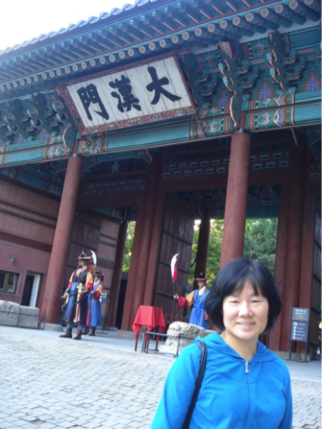
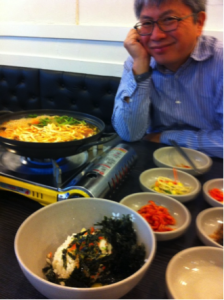
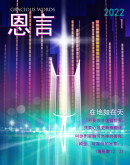
Leave a Reply